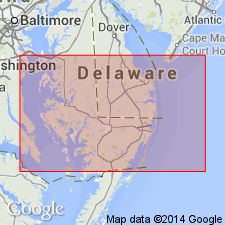
- Usage in publication:
-
- Sinepuxent Formation*
- Modifications:
-
- Named
- Dominant lithology:
-
- Sand
- Clay
- Peat
- AAPG geologic province:
-
- Atlantic Coast basin
Summary:
Sinepuxent Formation here named in the central Delmarva Peninsula. Consists of more than 18 m of micaceous sand with beds of black clay and peat. Sand coarsens upward and is fossiliferous. Interpreted as marginal marine deposit. Unconformably, from north to south, overlies Omar Formation, Ironshire Formation, Beaverdam Sand, and so-called "Yorktown(?) and Cohansey(?)" Formations. Age is Pleistocene (Wisconsinan).
Source: GNU records (USGS DDS-6; Reston GNULEX).
- Usage in publication:
-
- Sinepuxent Formation
- AAPG geologic province:
-
- Atlantic Coast basin
Ramsey, K.W., 2010, Stratigraphy, correlation, and depositional environments of the middle to late Pleistocene interglacial deposits of southern Delaware: Delaware Geological Survey Report of Investigations, no. 76, 43 p.
Summary:
Pg. 15+. Sinepuxent Formation of Assawoman Bay Group. [Not synopsized to date. See also Ramsey, K.W., 2010, Geol. map Georgetown quadrangle, Delaware Geol. Survey, Geol. Map Ser., no. 15, scale 1:24,000, and references therein.]
Source: NA
For more information, please contact Nancy Stamm, Geologic Names Committee Secretary.
Asterisk (*) indicates published by U.S. Geological Survey authors.
"No current usage" (†) implies that a name has been abandoned or has fallen into disuse. Former usage and, if known, replacement name given in parentheses ( ).
Slash (/) indicates name conflicts with nomenclatural guidelines (CSN, 1933; ACSN, 1961, 1970; NACSN, 1983, 2005, 2021). May be explained within brackets ([ ]).

